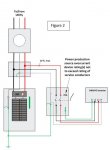There is frequently more than one way to do something that is code compliant.
Where's the alternative to the below then?
What exactly are you calling it to make the bonding in the disco *not* required?
If it's one service, all enclosures are bonded-250.28(2).
If it is two services, all enclosures are bonded.-250.24(B).
Is there another option?
250.24 Grounding Service-Supplied Alternating-Current Systems.
(A) System Grounding Connections. A premises wiring
system
supplied by a grounded ac service shall have a
grounding electrode conductor
connected to the grounded
service conductor, at each service, in accordance with
250.24(A)(1) through (A)(5).
(B) Main Bonding Jumper. For a grounded system, an unspliced
main bonding jumper shall be used to connect the
equipment grounding conductor(s) and the service-disconnect
enclosure to the grounded conductor
for
each service disconnect in accordance with 250.28.
Exception No.1: Where more than one service disconnecting
means is located in an assembly listed for use as service
equipment, an unspliced main bonding jumper shall
bond the grounded conductor(s) to the assembly enclosure.
250.28 Main Bonding Jumper and System Bonding
Jumper. For a grounded system, main bonding jumpers
and system bonding jumpers shall be installed as follows:
(2) Main Bonding Jumper for Service with More Than
One Enclosure.
Where a service consists of more than a
single enclosure as permitted in 230.71 (A), the
main bonding
jumper for each enclosure shall be sized in accordance
with 2S0.28(D)(l) based on the largest ungrounded service
conductor serving that enclosure.
(3) Separately Derived System with More Than One
Enclosure. Where
a separately derived system supplies
more than a single enclosure, the system bonding jumper
for each enclosure shall be sized in accordance with
2S0.28(D)(1) based on the largest ungrounded feeder conductor
serving that enclosure, or a single system bonding
jumper shall be installed at the source and sized in accordance
with 250.28(D)(1) based on the equivalent size of the
largest supply conductor determined by the largest sum of


